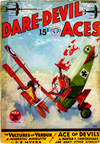“The Caterpillar Ace” by Frederick Blakeslee
Frederick Blakeslee painted all the covers for the entire run of Dare-Devil Aces. And each of those covers had a story behind it. Blakeslee illustrates an incident in the career of that great German Ace—Ernst Udet! His life was previously featured by Alden McWilliams in his “They Had What it Takes”, but here Blakeslee features the battle that led Udet to use a parachute for the first time, thus becoming “The Caterpillar Ace!”
 THE COVER this month illustrates an incident in the sky adventures of one of Germany’s great war aces—Ernst Udet. There is one slight discrepancy from fact in the painting. The Allied ship on the cover is an R.E.8, whereas Udet was engaged in combat with a Bristol Fighter. When the story was first told me the two planes were described as a Fokker triplane and an R.E.8. Later on—after the canvas was painted and just before this magazine went to press—I discovered the error, but it was too late to remedy it then. Outside of this, however, the picture depicts a great battle climax as it actually occurred in war skies.
THE COVER this month illustrates an incident in the sky adventures of one of Germany’s great war aces—Ernst Udet. There is one slight discrepancy from fact in the painting. The Allied ship on the cover is an R.E.8, whereas Udet was engaged in combat with a Bristol Fighter. When the story was first told me the two planes were described as a Fokker triplane and an R.E.8. Later on—after the canvas was painted and just before this magazine went to press—I discovered the error, but it was too late to remedy it then. Outside of this, however, the picture depicts a great battle climax as it actually occurred in war skies.
You will notice that the German pilot is wearing a parachute. Ernst Udet is the only war-time pilot to escape from a wrecked ship in a parachute—thus having the distinction of being the original member of the Caterpillar Club.
The event was remarkable since, on the day this happened, Udet was wearing a parachute for the first time and against his will. He had been ordered to do so as an experiment. Sighting a Bristol Fighter, he maneuvered onto its tail and when only about a dozen feet away opened fire. His tracers tacked a scam up the Bristol’s back into the gunner’s pit; the gunner slumped over, apparently dead.
Udet’s speed carried him beyond the Bristol. Careful not to give the .pilot chance for a shot at him, he swung around, again on its tail. As he came in close, holding his fire until he should be in perfect position, his eyes widened with horror. For the gunner—supposedly dead—was dragging himself upright, his face a mass of blood; swinging his guns around, he opened fire at point-blank range.
Before the astonished German ace could gather his wits, there was a rendering crash. His upper wing carried away—was shot away, rather—snapping the struts, and pulling the second and third wings with it. A split second later, the wingless fuselage began its plunge to earth.
It was then Udet remembered the unwanted bulk strapped to his back. Well, he might just as well try it. He would die anyway! So he leaped clear. The parachute, to his astonishment, opened and he floated easily to earth, landing in German territory. The pilot of the Bristol had been watching it all. He now came down low over where Udet had landed. The German waved his hand and the Bristol flew away south.
Udet fought under a lucky star. Sometime later, while flying a Fokker D-VII, he was rammed by a fire-eating Camel pilot and he crashed to earth, but was not severely injured.
Ernst Udet is Germany’s leading surviving ace, credited with sixty-two victories. He was respected by friend and foe alike for his sportsmanship in combat. Recently he came to the United States and flew for the movies. He is responsible for the really beautiful air shots in such movies as “The White Hell of Pitz Palu” and “Storm Over Mount Blanc.” Last summer he spent in Greenland working on the movie “S.O.S. Iceberg.” He is one of the most masterly stunt pilots in the world and is one of the few surviving aces who has not lost his cunning.

“The Caterpillar Ace: The Story Behind The Cover” by Frederick M. Blakeslee (November 1933)
Check back again. We will be presenting more of Blakeslee’s Stories behind his cover illustrations.




